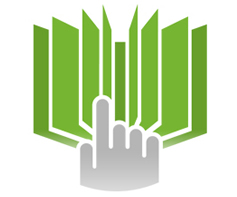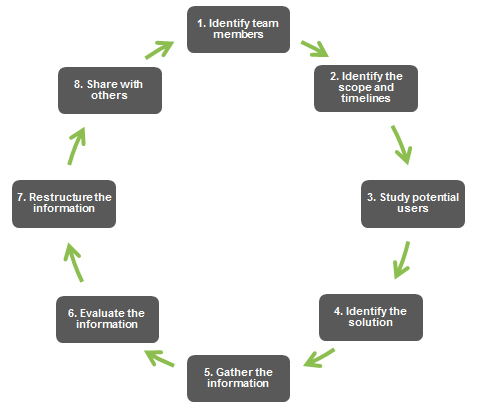Information Consolidation: Organizational Spring Cleaning (Part 2)
In part one of this three-part article series, we started thinking about why your organization's files might need a good "spring cleaning." Now, in part two, we will outline the initial steps you can use to de-clutter and streamline your company's information assets.

Remember, the easier it is to locate your critical business resources, the more efficient and productive your employees become.
~ ~ ~ ~ ~ ~ ~ ~ ~ ~The Information Consolidation Process
The following diagram depicts an eight-step process your organization can use to spring clean all your information resources.

To better understand the process in your organization, let's compare it to doing spring cleaning in your home.
1. |
Identify team members and their roles in the process |
Home Spring Cleaning:
First, identify who should be involved in decision making and the actual cleaning.
- Will the parents be the primary stakeholders, or will the kids have an equal say?
- What about friends and neighbors who may borrow some of the belongings-do you want their input?
- Who can you recruit to do the manual labor?
Organization Information Consolidation:
First, identify people to have on the project-both champions and key stakeholders. Champions are those who see the value of information consolidation and will drive and support the process. Key stakeholders will support the process to make the change effective and lasting.
Your team members may include:
- End users of the information resources
- Subject matter experts, who will help evaluate and identify the right information to keep
- Information technology, who may help provide a solution for managing the information
- Managers, who create and update processes and standards, and whose employees use the information
- Compliance management and human resources teams, who can provide input on what information is most relevant and current
When recruiting team members, be sure to share the process with them and estimate their involvement to manage their expectations. You may also need permission from their managers for their participation.
2. |
Identify the scope of information consolidation and break it into realistic chunks and timelines |
Home Spring Cleaning:
Answer these questions about your spring cleaning: Will you only be cleaning the garage? All the bedrooms? Then entire home?
Also determine when you will be doing the cleaning. Will you take next week off work? Will this be done on Saturday afternoons for the four weeks?
Organization Information Consolidation:
To determine the scope of the information consolidation, keep in mind that, although it's a great idea to reorganize as much information as possible, it's smart to perform the process in manageable chunks. So, should you start with one specific user group, such as call center level one agents or sales reps? Should you start with a department, such as Human Resources or Marketing?
To help you decide, you may want to meet with each group individually to analyze their needs, processes and current method of organization. This can help you prioritize needs and determine an appropriate timeline for implementation based on the availability of the team members.
3. |
Study potential users |
Home Spring Cleaning:
Next, consider family activities and how the household items are used. For example:
- Watch what toys and technology your family uses most (what you end up picking up off the floor the most) and ask their opinions on things that don't get touched for a while.
- If there's a treadmill that's so covered in dust that you know nobody in your house has used it in years, you may choose to donate it.
- But that 80-inch plasma TV screen that the family watches 18 hours a day is a "must keep."
Organization Information Consolidation:
The end user is undoubtedly the most important aspect of all information consolidation activities. Therefore, it's imperative to understand:
- How they currently use information
- Their current struggles
- Their job duties and daily tasks
- How information could be best organized to fit their existing activities
To gather this data, you can watch on-the-job performance, conduct informal surveys or hold a formal study. Whatever works best for the audience. Regardless of the method, be sure to include the following key tasks:
- Determine the specific objectives of the study.
- Identify study participants from the target end user audience.
- Collect surveys/questionnaires/observations and hold group discussions to gain additional insight on what they might need.
- Gather samples of what the participants consider effective and ineffective resources, and have them explain their choices.
- Consolidate all your observations in a findings report, and gain consensus from all participants on its content. Then share the report with key stakeholders to obtain their insight.
4. |
Identify potential information management solutions, and select the one that best meets users' needs |
Home Spring Cleaning:
It's time to think about how you will organize and store all the items you choose to keep. Do you need storage or shelving systems? Can everything fit in closets? Should winter items be separated from summer items?
Based on factors such as the most commonly used items, seasonality and size, you decide to head to the home storage superstore and find the perfect solutions.
Organization Information Consolidation:
At this point, you should identify the information management solution you intend to use so it can be developed or customized as you proceed through the process.
Are you surprised to see this step so late in the process?
Think about this: It is well known that information systems have a high rate of failure if users' needs are not considered when selecting and designing the systems.
Why would you choose a solution before you know what users need? Many companies make this mistake: they choose and start customizing a solution as the first step in the process, and then they spend countless hours trying to retrofit it to users' needs. Or, worse yet, they try to adjust user activities to fit the solution.
So choose your solution after you are familiar with the end users' habits and preferences. You may choose a learning management system (LMS), CMS, Sharepoint page, intranet site, network drive, printed manuals or some other solution...whatever will work best to support the users' needs.
Do you have any thoughts you would like to share regarding these first four steps in the information consolidation process? Please join the conversation in the comments section of this article or feel free to send us an email. We'd love to hear your thoughts!
Continue reading:
Information Consolidation: Organizational Spring Cleaning (Part 1) →
Information Consolidation: Organizational Spring Cleaning (Part 3) →



